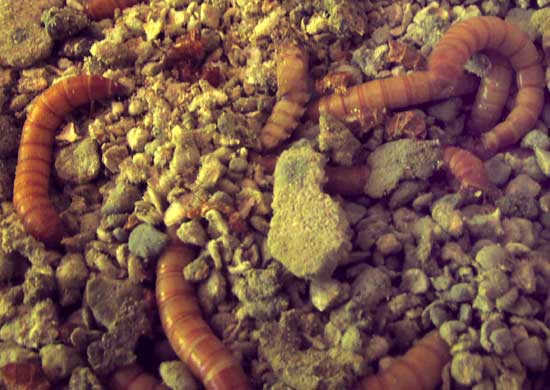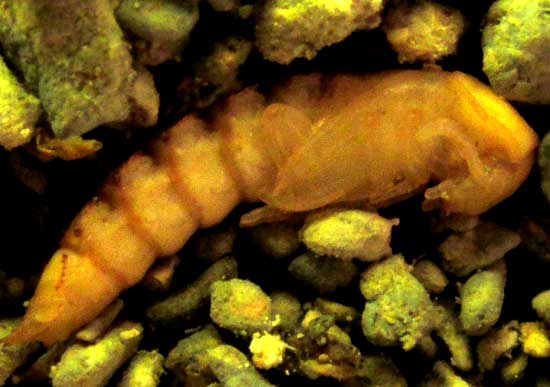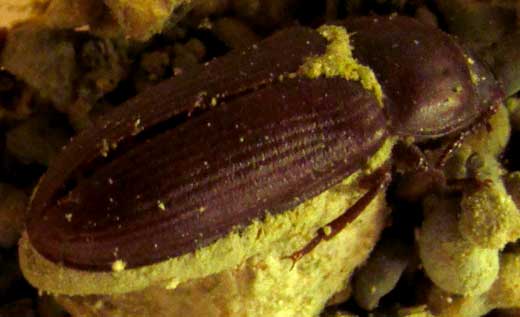Excerpts from Jim Conrad's
Naturalist Newsletter
from the June 21, 2018 Newsletter issued from Rancho Regenesis in the woods ±4kms west of Ek Balam Ruins; elevation ~40m (~130 ft), N~20.876°, W~88.170°; central Yucatán, MÉXICO
GROWING MEALWORMS
Lee, who owns the rancho and the Genesis eco-resort in Ek Balam where I get my Internet connection, brought over to me a Tupperware-like plastic container, pried off the lid, and showed me her new pets. Below, you can see a few of them:

They're mealworms -- the larvae of the Mealworm Beetle, TENEBRIO MOLITOR, of the Darkling Beetle Family, the Tenebrionidae. A fellow in Mérida had supplied her with some.
In that picture, notice that the individual at the top, center looks a bit different. That's a mealworm entering its pupal stage, the last stage during the process of complete metamorphosis before becoming an adult. A close-up of a pupa looking like mealworm on one end but changing winged beetle on the other, is shown below:

In that picture you can see that there's a problem. Notice how powdery material coats each pebble-like grain. It's fungus, and once we started looking closely we realized that the whole mealworm farm was heavily contaminated with fungus, probably because a big, watery slice of mango had been given them to eat. The box's humidity had risen to levels perfect for fungi.
Mealworm pupa need three to thirty days to metamorphose into adults, the time depending mainly on temperature. Lee's farm had just been established, so I could find only one adult Mealworm Beetle, but he was in a mess, his soft parts heavily coated with fungus, and he was barely moving about. Below, you can see the poor thing:

Immediately Lee got a new container, filled it with oatmeal, and transferred her larvae to the new farm, where they have been thriving.
In the past, mealworms have been thought of mostly as pests, because they feed on people's stored grains. In Asia, however, traditionally they've been eaten, commonly being sold in food markets and along streets. In fact, more and more the rest of the world's health food industry is marketing baked and fried Mealworms as a high-protein snack option. Mealworm larvae contain levels of potassium, copper, sodium, selenium, iron and zinc that rival beef, and have greater vitamin content by weight compared to beef, except for vitamin B12. The eating of insects is called "entomophagy."
Lee was interested in garbage disposal, so I did some work with the search engine. The big surprise was learning that mealworms can degrade polystyrene into usable organic matter. Moreover, no difference was found between mealworms fed only styrofoam, and those fed conventional foods. This information was in Rob Jordan's 2016 article "Plastic-eating worms may offer solution to mounting waste, Stanford researchers discover," downloadable from the Stanford News Service.
If you want to try your own experiments, you can order mealworms on the Internet. Normally they are reared on fresh oats, wheat bran or grain, with sliced potato, carrots or apple as a moisture source, just being sure not to add too much wet stuff.